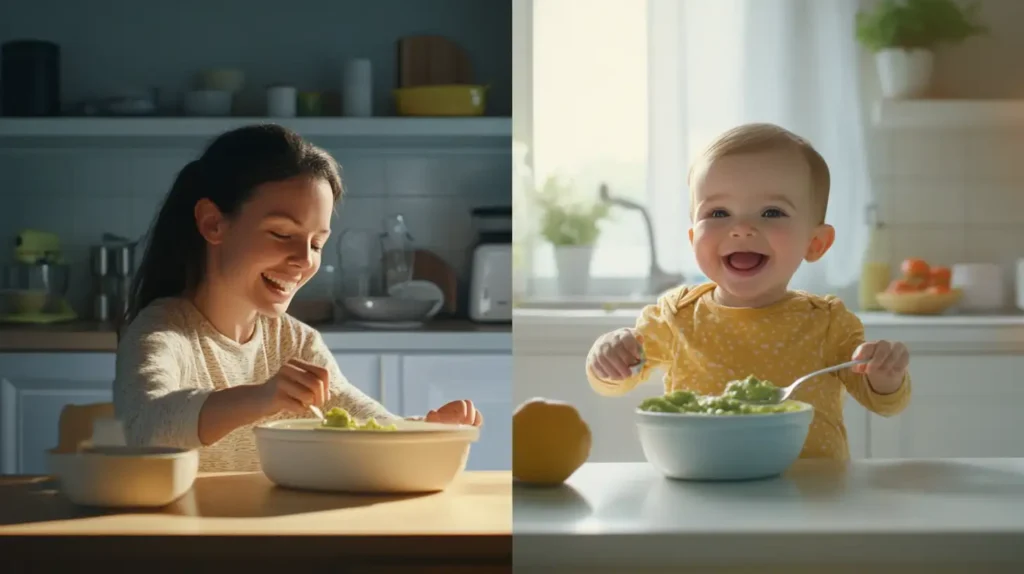Table of Contents
ToggleThe Baby Food Revolution: Why That Fancy Processor Might Not Be What You Think
This may sound shocking, but the way to nourish your little one isn’t what most baby stores want you to believe. Have you ever felt that rush of excitement scrolling through those glossy baby food processors online, convinced they’re the secret to raising a healthy eater? Maybe you’ve been eyeing that $200 steamer-blender combo that promises organic perfection at the touch of a button, or perhaps you’re drowning in recommendations from well-meaning friends about gadgets you absolutely cannot parent without.
In this article, I’m going to share something I really wish someone had told me before I maxed out my credit card on baby feeding gear that now collects dust in my cabinet.
I shared this revelation with a sleep-deprived friend over coffee last week. She was so overwhelmed by the feeding journey ahead – the equipment, the techniques, the cleanup, the investment – that she’d been putting off starting solids altogether. The anxiety was real, and I recognized that desperate look in her eyes because I’d been there myself just months earlier.
Let me explain how all of this works. I used to overthink everything about feeding my baby. Every purchase, every meal, every bite. And I thought if I just invested in the right equipment and followed the perfect system, my baby would be a champion eater with a sophisticated palate by their first birthday. But in reality, all this pressure and perfectionism was just making mealtime miserable for both of us.
So I made a change, and it transformed not just how we approach food, but how I parent overall. I stopped caring about having the perfect setup. I stopped caring about recreating Instagram-worthy baby food spreads. I stopped caring about whether my methods matched what the mommy bloggers were promoting.
And truly, this changed everything for us.

The Great Baby Feeding Industry Illusion
Here’s the biggest mistake most new parents make. We think by investing heavily in specialized equipment, that will somehow guarantee feeding success. We believe that if we just want our babies to eat well badly enough and buy all the right gear, it will happen.
I mean, you hear all the things on social media and in parenting groups, right? This machine changed our lives! or My baby wouldn’t eat until we got this processor!
Now, I’m not saying you shouldn’t care about what goes into your baby’s body or invest in tools that genuinely help. But what I am saying is that you should approach this journey with a clear head about what actually matters.
The outcome – a well-fed, happy child – doesn’t depend on whether you spent $200 on a specialized baby food machine or used your regular blender. It depends on you showing up consistently, offering variety, staying patient, and creating positive eating experiences.
But sometimes, don’t you feel the opposite pressure in your life? Think about it – the more desperate you are to get your baby to eat perfectly, the more stressed you become at mealtime. Your anxiety transfers to your baby, who senses the tension and becomes less interested in exploring food. The more specialized equipment you buy, the more complicated mealtime becomes, with extra parts to clean and systems to maintain.
The more you chase this idea of perfect baby nutrition through expensive equipment, the harder it feels to actually enjoy the feeding journey. Because complexity often breeds overwhelm, while simplicity attracts ease.
And there’s a reason why parents who keep things simple often seem to have the most relaxed mealtimes and adventurous eaters. When you’re no longer holding on to specific outcomes or complex systems, you show up differently. You become calmer, more present, and much more responsive to your baby’s actual needs.
The irony is that’s when feeding starts to fall into place.

Finding Freedom in the Baby Food Middle Ground
This brings me to my next point – embracing the middle path between convenience and complexity.
Let me be clear – this isn’t about being careless with your baby’s nutrition. It’s about being free to detach yourself from the belief that specialized equipment equals better parenting or healthier babies.
Imagine how it would feel to be free from the anxiety of equipment comparison. Free from overthinking each feeding tool purchase. Free from the fear of somehow doing it wrong because you’re not using what everyone else seems to be using.
Here’s the truth: If that specialized baby food processor makes your life genuinely easier and you have the budget for it, great! If not, your regular kitchen tools will work beautifully. If the baby food pouches work for your on-the-go lifestyle, amazing. If hand-mashed foods prepared in batches suits your rhythm better, that path will serve you just as well.
Either way, your baby is going to be okay. I promise.
The best parents I know, they care deeply about nutrition, but they’re not attached to specific methods or equipment. They show up, they give their best with whatever tools they have available, and then they let go of perfectionism. Because they know if they’ve provided nutritious options in a positive environment, they’ve already won.
And so have you.
It’s time we all embrace this with or without energy about baby feeding equipment – the feeling that you’re going to nourish your child well no matter what tools you have at your disposal. That confidence helps you approach mealtime with joy rather than stress with every single bite.

Breaking Down the Real Costs and Benefits
When I moved back home to Trinidad after my first was born, my mother laughed when she saw me unpacking my fancy baby food maker. What’s wrong with the fork and pot I raised you with? she asked in her musical Caribbean accent. At first, I defended my purchase, but after a few weeks of her simple approach, I realized she had a point.
Let’s talk actual numbers and practical considerations to help you make choices that make sense for YOUR family:
-
Specialized Baby Food Processor ($150-250): These all-in-one systems steam and puree in the same container. They save about 10-15 minutes per batch by eliminating the transfer between cooking and blending. But they take up significant counter space, have specialized parts that can be difficult to replace, and often can only process small batches at a time.
-
Standard Blender or Food Processor You Already Own ($0 additional): Takes an extra step of transferring food from cooking method to blending, but typically can handle larger batches at once. Multipurpose use means it earns its kitchen space beyond the baby food stage.
-
Hand-Powered Food Mill ($20-40): Low-tech but effective for creating texture-appropriate foods. No electricity needed, making it perfect for travel or homes with unreliable power (something my island relatives appreciated during hurricane season). The trade-off is more manual effort.
-
Basic Tools ($5-15): A fork, potato masher, or inexpensive hand blender can create everything from smooth purees to chunky textures as your baby develops. These approaches require no special storage and minimal investment.
But the real cost analysis goes beyond the price tag. Consider:
-
Storage Space: In my modest apartment, cabinet real estate was more valuable than I initially realized. That impressive baby food system competed with everyday essentials.
-
Cleaning Time: Those specialized systems often have multiple, intricate parts that need thorough cleaning between uses – sometimes adding 10 minutes to your process.
-
Longevity: The puree stage typically lasts about 4-6 months before babies transition to more textured foods. Will a single-purpose device justify its cost and space for such a temporary phase?
-
Flexibility: Can the equipment grow with your child’s changing needs or adapt to different food textures as they develop?
The most powerful thing I discovered is that when you embrace your journey as a parent versus trying to achieve some Instagram-perfect feeding setup, you’ll actually find more joy and success than you thought possible. Knowing that what you already have in your kitchen is enough – truly enough – for this world and for your baby’s needs.
Taking that next step forward without knowing exactly how it will end, but trusting in your ability to nourish your child regardless of equipment – that is the secret to peaceful mealtimes.

When Specialized Equipment Actually Makes Sense
Now, I’m not entirely anti-baby food gadgets. There are legitimate situations where specialized equipment truly earns its keep.
If you recognize yourself in any of these scenarios, that baby food processor might actually be worth the investment:
-
Time-Pressed Parents: If both parents work full-time with minimal flexibility and limited meal prep windows, an all-in-one system that reduces active cooking time could be genuinely valuable.
-
Cooking-Averse Households: If cooking is not already happening regularly in your home, and the alternative is primarily store-bought options, a simple baby-specific system might encourage more homemade meals.
-
Special Dietary Needs: For babies with allergies, sensitivities, or medical conditions requiring carefully controlled ingredients, the precision and consistency of specialized equipment might be beneficial.
-
Travel-Heavy Lifestyles: Some portable baby food makers can be useful for families who are frequently on the go, staying in hotels, or visiting places where kitchen access is limited.
-
Limited Kitchen Setup: If your living situation doesn’t include a full kitchen, some all-in-one baby food makers might actually expand your food preparation capabilities.
What matters is making a clear-eyed decision based on your actual life circumstances, not based on fear or external pressure.
The night before my daughter’s first birthday, I finally donated that barely-used baby food processor. I realized it represented something important – my journey from anxious, overthinking new mom to someone who had found her confidence. Someone who realized that processing food for my baby was about love and nutrition, not about having specialized equipment.
This really brings me to the point that this fear of somehow failing your baby because you’re not using the right equipment – it’s really just a story you’re telling yourself. Because at the end of the day, the people who matter – especially your growing, thriving child – they won’t mind what device mashed their sweet potatoes. And for the people who might judge your kitchen tools or baby feeding approach, well, they don’t matter in your parenting journey.

Creating Your Own Smart Solution
So where does this leave you, standing in the baby store aisle or hovering over that online shopping cart full of feeding equipment?
I want to offer you a practical framework for making decisions that will actually serve your family. Because that’s what matters most – not what worked for me or what some influencer is promoting, but what genuinely makes feeding your unique baby in your unique circumstances easier and more joyful.
Start by honestly assessing your situation:
-
What cooking tools do you already own and regularly use? Many standard kitchen items can multitask as baby food equipment.
-
How much food prep time realistically fits into your schedule? Be honest about whether batch cooking or meal-by-meal preparation suits your lifestyle better.
-
What’s your budget comfort zone? Set a clear limit that doesn’t create financial stress.
-
How much kitchen space can you dedicate to baby-specific items? Consider whether items will need to be stored or can remain on countertops.
-
What feeding approach resonates with your parenting philosophy? Whether traditional purees, baby-led weaning, or a combination approach, different methods require different tools.
Then, consider starting with the simplest solution first:
-
Phase 1: Use what you have – A fork, potato masher, or blender you already own can create perfectly appropriate first foods.
-
Phase 2: Add strategically – If you identify specific friction points in your feeding routine, add only the tools that address those specific challenges.
-
Phase 3: Adjust as your baby grows – Remember that baby feeding equipment needs evolve quickly as your child develops new eating skills.
Consider a hybrid approach. My cousin in Jamaica taught me her brilliant system – she used a standard blender for big batch cooking on Sundays, freezing portions in ice cube trays. Then she had an inexpensive hand-powered food mill that traveled with them for meals away from home. Total investment: under $30, and her daughter is now a adventurous five-year-old eater who tries everything.
The best high performers in parenting – they aren’t the ones with the most equipment or the perfect feeding schedule. They’re the ones who’ve figured out systems that work for their unique family dynamics and who remain flexible as their children grow and change.
That flexibility is worth more than any appliance you could buy.
The Freedom of Your Own Path
Whenever you’re reading this article, I want you to have the courage, clarity, and power to feed your baby on your own terms. Because you become a more confident parent when you stop caring about having the perfect equipment and you become an unstoppable force when you trust your own instincts.
If you’ve given your baby nutritious foods prepared with love and attention, then you have already won, regardless of what tools you used to prepare them.
In our modern parenting world, we’re bombarded with messages that we need specialized everything – from wipes warmers to baby food processors to sensory toys in specific developmental shades. But our grandmothers raised healthy, happy children with basic tools and intuitive wisdom. There’s profound freedom in reconnecting with that simplicity.
I discovered this wisdom one sweltering afternoon in my kitchen. The power had gone out (island life!), and my fancy baby food maker sat useless on the counter. My daughter was hungry, avocados were ripe, and dinner needed to happen. With nothing but a fork and a bit of breast milk, I mashed up the perfect first food. The look of delight on her face as she experienced that simple, lovingly prepared avocado taught me everything I needed to know.
Sometimes, the most powerful parenting moments come when our carefully laid plans get disrupted and we’re forced to simplify.
So here’s my challenge to you: Before you invest in specialized baby feeding equipment, try a two-week experiment using only what you already have in your kitchen. You might discover, as I did, that the basics are not just adequate – they’re actually preferable in many ways.
If after those two weeks you still feel a specialized tool would significantly improve your baby feeding journey, then make that purchase with confidence rather than fear or pressure.
Remember that your relationship with your baby and the joy you bring to mealtimes matters infinitely more than the equipment you use to prepare their food. When you approach feeding with calm confidence rather than anxious perfectionism, you’re giving your child the most important nourishment of all – positive food associations that will serve them for a lifetime.
Thank you for being here, for doing the thoughtful work of parenting with intention. The very fact that you’re reading this means you care deeply about nourishing your little one well, and that care – not any appliance – is what will make all the difference.
Beyond her professional achievements, Jessica is also a successful mother to a large and thriving family. Her firsthand experience in balancing financial responsibilities while raising multiple children gives her a unique perspective that resonates with her audience. As a mother, Jessica understands the financial challenges and pressures faced by families, and she brings a compassionate and relatable approach to her blogging. Through her blog, Jessica not only shares her financial expertise but also provides invaluable insights on how to foster financial well-being while building a strong and harmonious family foundation. Whether it's budgeting, saving for college, or teaching children about money, Jessica's relatable stories and practical tips make her an indispensable guide for individuals striving to achieve financial stability while nurturing a fulfilling family life.



